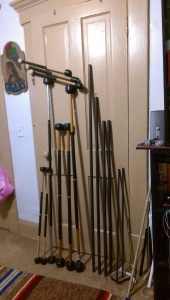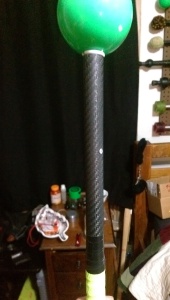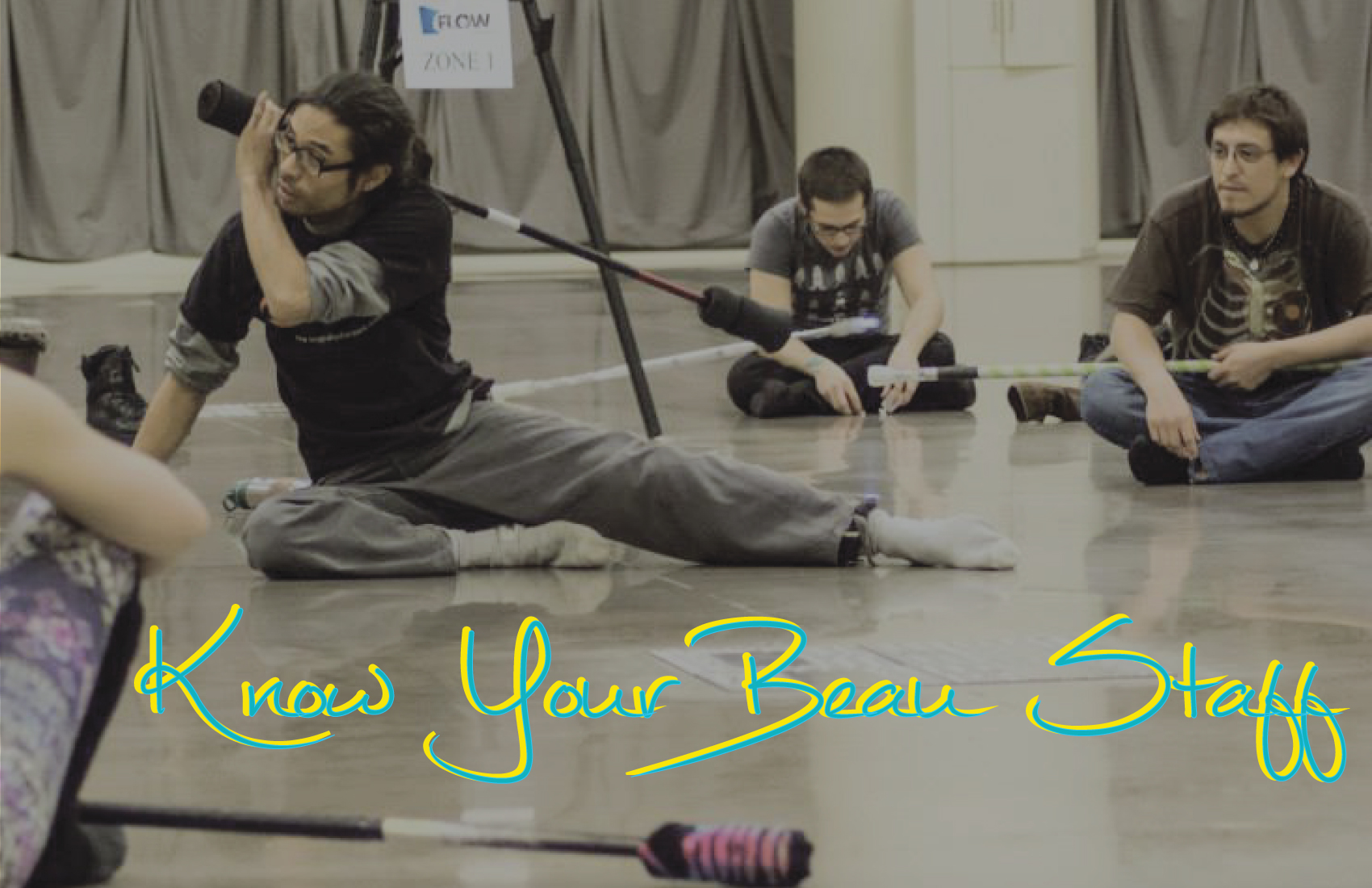First and foremost, if you didn’t at least chuckle at the pun in the title, get out. (It’s pronounced “bo staff”), and traditionally, the staff is called a bo staff.

So let’s talk about materials. Contact staves come in a myriad of different shapes and styles, and every prop-smith will have their own personal flair, but ultimately each staff boils down to a few universal components: the stick, the ends, and the grip. Every material has benefits and drawbacks, and Googling all of that takes a lot of time that could be spent spinning your sticks. In the interest of you spinning your sticks, I’m going to walk you through the most common materials you’ll encounter, and help you build or buy your staff with confidence, because knowledge is power!\
The Stick
The stick portion of your staff is the long, staff-shaped part. Its primary purpose is to be a stick, which you may then spin.
Aluminum – The most common stick material, aluminum comes in many different grades. A $4 tube of aluminum conduct from your local hardware store can create a perfectly functional, albeit more likely to bend when dropped, practice contact staff, and a tube of high quality aluminum (6061 or 7075 being the standard) will often outlive its owner.
Wood – A budget-friendly alternative, hardwood staves tend to be bouncier, making tosses harder and hitting yourself not quite as punishing. Most commonly wood is used to make a large quantity of practice staves, as a hardwood broomstick is $5 and makes a 5′ staff.
Carbon Fiber – Recently carbon fiber has gained a lot of popularity in the stick-spinning community. It is both durable and beautiful, making it equally valued for acrostaves and performance ones, so expect to pay a premium for it!
The Ends/Weights
The most common end you’ll see on a staff are kevlar wicks, usually (hopefully)  adorned with a protective cover. The ends serve to place weight at the tips of the staff, maintaining momentum and allowing for contact manipulation.
adorned with a protective cover. The ends serve to place weight at the tips of the staff, maintaining momentum and allowing for contact manipulation.
Kevlar Wicks – If you’re going to spin fire, you’re going to need wicks. These staves are usually made with 3 feet of 3-5 inch wide kevlar wrapped around the stick, and a wooden core placed inside it. It is highly advisable that you use wick covers when practicing with kevlar wicks, as kevlar can be degraded by UV rays, and sudden collisions.
Bike Tire Inner Tubes – These are the most common end-weights for practice staves, as they are easy to source (ask any bike shop for their trash ones), easy to apply, and extremely durable. Bike tubes are rolled around the staff in a similar manner as a wick, and affixed with epoxy, tape, or other means of your choice.
Balls – Tennis balls, stage balls, rubber balls from the dollar store, lacrosse balls, big balls, small balls, whatever your pleasure, put it on your staff. Fill a tennis ball with uncooked rice, and nail it to your stick, epoxy a stage ball on, etc – Be creative!
Grips
They make the stick stick to you.
Tennis Racket Grip – The most commonly used contact staff grip, there are scores of different styles, textures, and colors.
Silicone Sleeving – This thin tube of silicone creates an incredibly tacky staff that grips like nobody’s business. It’s extremely easy to keep clean with just a dampened cloth. The downside is that humidity and sweat make this grip downright slippery
Bike Handlebar Cork – This colorful grip costs more than most other options. It provides a decent amount of grip, and a great cushioned feel. Over time it becomes more tacky as the material breaks in.
Bike Tire Innertubes – Always the budget-friendly option, tire tubes can be split lengthwise and wrapped around your staff for a grip that is exceedingly durable, although minimally tacky. It’ll get the job done, but it’s not recommended long term.
Contact staves come in many varieties and styles, and it’s ultimately up to you to make sure that your gear is up to the tasks you throw at it. Hopefully this guide helps you choose the right materials to make your staff yours.
If you want to upgrade to something a little more flashy, consider one of our sponsors, Flowtoys, composite LED staffs.


Comments 2
Keep keepin’ on please and keep Me in contact … Pun intended …
First came the desire, then the seeking, then the discovery that the answers were within …
Now comes the theory flowing to me at the very right time.
Thank you – Jan Dance
Marvelous, what a website it is! This webpage presents valuable facts to us, keep it up.